calsfoundation@cals.org
Redfield (Jefferson County)
| Latitude and Longitude: | 34°26’42″N 092°11’00″W |
| Elevation: | 302 feet |
| Area: | 3.09 square miles (2020 Census) |
| Population: | 1,505 (2020 Census) |
| Incorporation Date: | October 18, 1898 |
Historical Population as per the U.S. Census:
|
1810 |
1820 |
1830 |
1840 |
1850 |
1860 |
1870 |
1880 |
1890 |
1900 |
|
– |
– |
– |
– |
– |
– |
– |
– |
400 |
333 |
|
1910 |
1920 |
1930 |
1940 |
1950 |
1960 |
1970 |
1980 |
1990 |
2000 |
|
278 |
296 |
350 |
339 |
291 |
242 |
277 |
745 |
1,082 |
1,157 |
|
2010 |
2020 | ||||||||
|
1,297 |
1,505 |
Redfield is a growing city located in Jefferson County near Interstate 530, which connects Pine Bluff (Jefferson County) and Little Rock (Pulaski County). The city has always relied on land transportation, beginning in the nineteenth century with the railroad and continuing in the twentieth and twenty-first centuries with highways.
The Little Rock, Mississippi River, and Texas Railroad built a line from Chicot Point (Chicot County) to Pine Bluff in 1873. Financial problems that year delayed completion of the line to Little Rock for several years, but James Kirkwood Brodie anticipated the completion of the line and invested in land along its route. For $71.28, Brodie bought 163 acres from the State of Arkansas, land that had been seized from the former owners for failure to pay taxes. Brodie also bought half-interest in 120 acres adjacent to his land. In August 1880, Brodie sold a 300-foot right-of-way through his land to the railroad and immediately hired John Martin, the Jefferson County surveyor, to plat a city on his land. The city was named Redfield for Jared E. Redfield, who was president of the railroad from 1875 to 1881.
In 1885, An African American man named David Scruggs was lynched by a Black mob for having allegedly raped his own daughter.
At first, Redfield was a lumber town, with a sawmill that processed oak, hickory, gum, pine, and cypress trees grown in the area. Voters made Redfield a “dry” city by prohibiting the sale of alcohol in 1888. A one-room schoolhouse was built in 1882. By 1890, the business district of Redfield included five stores, two gins, two grist mills, two warehouses, three hotels, a drugstore, a meat shop, two barbers, and three physicians. The city also had four churches: two Baptist churches and two Methodist churches (one of each denomination for whites and African Americans). Agriculture in the region featured not only cotton but also grapes, plums, berries, and vegetables. The city was incorporated late in 1898 and held its first election on January 3, 1899.
Nearly the entire business district of Redfield was destroyed by a fire on February 24, 1903. Nine businesses were lost, with only one hotel and one store surviving the blaze. Arson was suspected, largely because an equally suspicious fire struck the cotton gin on Mayor A. F. McNeill’s farm on the same evening, but no one was ever arrested or charged for the crime. Businesses were rebuilt, and the city continued to grow; it was considered the most important train stop between Little Rock and Pine Bluff. Already, though, train traffic had competition, as one of the first major highways between the cities was built through Redfield in 1913. Portions of the road, known as the Dollarway Highway, have been preserved and are listed on the National Register of Historic Places. A bridge for automobile traffic, built in Redfield in 1924, is also listed on the National Register.
In June 1915, the Redfield Canning and Pickling Company was incorporated in Redfield and became one of the principal employers in the area. The city continued to thrive until the Depression, when the farm economy collapsed due to low prices. The population of the city did not return to former levels until the White Bluff Generating Plant, a coal-burning plant to generate electricity, was completed in Redfield in 1980. Improvements on U.S. Highway 65, which was designated Interstate 530 in 1999, have brought more traffic through the Redfield area, resulting in the success of stores and restaurants serving travelers and local customers. The railroad line, which for many years was part of the Missouri Pacific system and is now part of the Union Pacific system, continues to operate through Redfield and employs some citizens.
A school was built in Redfield with the help of the Works Progress Administration (WPA) in 1939. The WPA school replaced a three-story 1914 school that was torn down. In January 2013, the White Hall School Board voted to close the Redfield WPA campus. The two schools in Redfield in the twenty-first century are part of the White Hall School District. By 2013, M. A. Hardin Elementary School had about 300 students, and Redfield Junior High School had just over 100 students. The population of Redfield in the 2010 census was 1,297, of whom 1,189 were white, sixty-two were African American, and twenty-three were Hispanic. The population grew moderately by the next census.
Conley F Byrd, a lawyer and a justice of the Arkansas Supreme Court, spent the latter part of his life living in Redfield. The KATV tower, before its collapse in 2008, stood just north of Redfield and was one of the tallest manmade structures in the world.
For additional information:
City of Redfield. http://www.redfieldar.com/ (accessed August 6, 2022).
Leslie, James W. “Redfield History Tied to Railroad Growth.” Pine Bluff Commercial, July 9, 1978, p. 15.
Parsons, Ken, Jr. “A $30,000 Fire.” Jefferson County Historical Quarterly 14 (Number 1, 1986): 18–19.
———. “Golden Anniversary Redfield School.” Jefferson County Historical Quarterly 16 (Number 1, 1988): 23–29.
———. “Redfield Remembered.” Jefferson County Historical Quarterly 10 (Number 4, 1982): 33–42.
Steven Teske
Butler Center for Arkansas Studies
 Dollarway Road near Redfield
Dollarway Road near Redfield 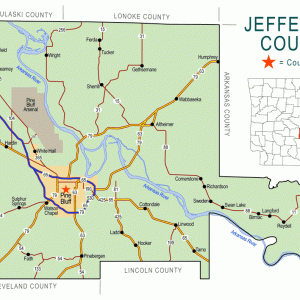 Jefferson County Map
Jefferson County Map  Redfield City Hall
Redfield City Hall 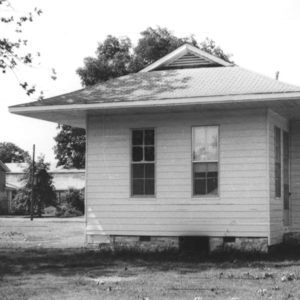 Redfield Depot
Redfield Depot  Redfield Fire Department
Redfield Fire Department 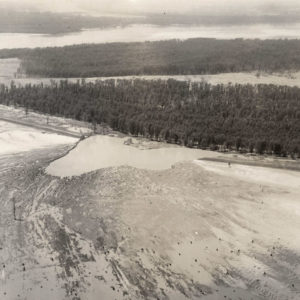 Redfield Flood
Redfield Flood  Redfield Historic School District
Redfield Historic School District  Redfield Library
Redfield Library 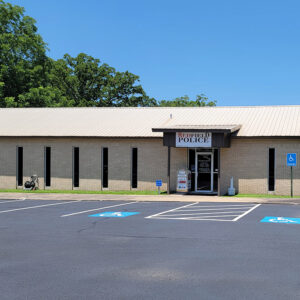 Redfield Police Department
Redfield Police Department  Redfield Post Office
Redfield Post Office  Redfield School
Redfield School 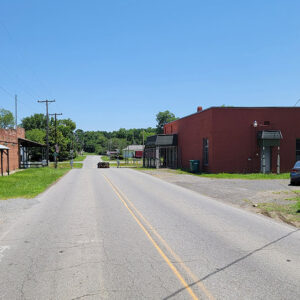 Redfield Street Scene
Redfield Street Scene 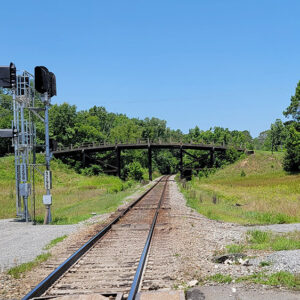 Redfield Viaduct
Redfield Viaduct  White Bluff Station
White Bluff Station 




The 1939 WPA school replaced a three-story 1914 school that was torn down. It opened the 1939-40 school year serving grades 1-12 students and was called the Redfield High School in Redfield School District # 31 and remained so until 1949 when Initiated Act # 1 of 1948 required that any district of fewer than 350 consolidate with another district. In 1949-50, Redfield joined the Jefferson County School District # 6. It consolidated with the White Hall School District # 27 in May 1950. Grades 10-12 from Redfield started attending the White Hall High School the 1950-51 school year. All students in grades 1-9 in the Redfield area continued to attend the WPA school in Redfield. In 1977, a new elementary school opened, moving grades 1-5 from the WPA school to Hardin Elementary. Later, Grade 6 was moved to the elementary school and Grade 9 moved from the Redfield WPA school to White Hall, thus creating the Redfield Middle School.
In January 2013, the White Hall School Board voted to close the Redfield WPA campus. The school had been built in 1939 to replace the 1914 school, sending all students in grades 6-12 to White Hall. Gone are the basketball games and all of the activities a junior high or middle school can generate. This WPA school has been the heartbeat of Redfield since it was built in 1939. The school mascot was the lion. We loved it so much. The building has beautiful strip hardwood floors, an elevated stage with velvet curtains, a homey kitchen, large double-hung windows with great natural lighting, a high pitched roof, and solid brick veneer all around. It is stately, and we cherish it. The back of the school had a teacherage for the principal or headmaster. One, Mr. Miles Tillery, was there for more than twenty years. This was later converted to a science class and lab. The property also had a well house and carriage house from the old 1914 school, and two grave sites from circa 1890 (the markers have been destroyed). The community of Redfield was able to purchase the 1939 WPA school and gymnasium from the White Hall School District in January 2014 through a sealed-bid process whereby the grass-roots organization Keep Redfield Middle School paid $70,112 for it. It is now known as the Keep Redfield Middle School Community Center, and we are in the process of placing it on the National Register of Historic Places. A mural in the cafeteria was completed in 2013 by art students.